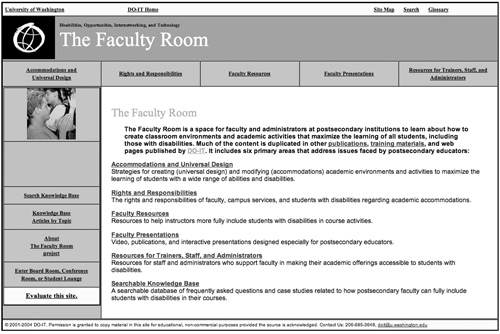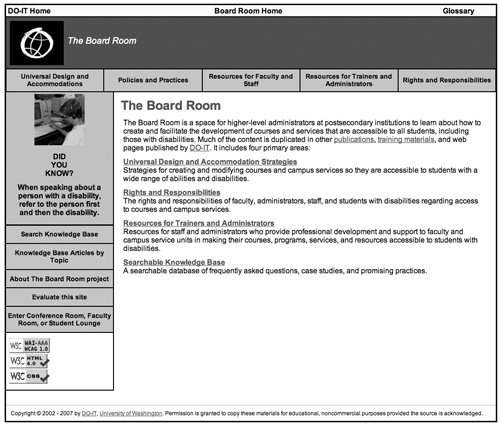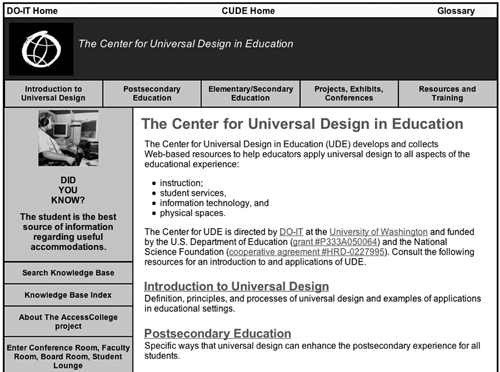Resources
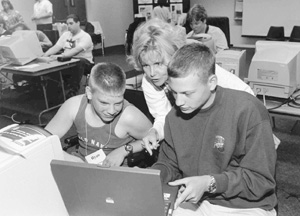
This Resources section contains references to publications and web resources cited in the text of these materials, templates for overhead materials that can be used in presentations, training videos in DVD format, and a sample of photocopy-ready handouts for presentations.
References
Publications
The following publications are referenced in these materials.
Blackorby, J., & Wagner, M. (1996). Longitudinal post school outcomes of youth with disabilities: Findings from the National Longitudinal Transition Study. Exceptional Children, 62, 399-413.
Burgstahler, S. (Ed.). (2002). Building the team: Faculty, staff, and students working together. Seattle: DO-IT, University of Washington. Retrieved August 1, 2007.
Burgstahler, S. (Ed.). (2005). Students with disabilities and campus services: Building the team. Seattle: DO-IT, University of Washington. Retrieved August 1, 2007.
Burgstahler, S. (2007a). Applications of Universal Design in Education (UDE). Seattle: DO-IT, University of Washington. Retrieved August 1, 2007.
Burgstahler, S. (2007b). Equal Access: Universal Design of Instruction. Seattle: DO-IT, University of Washington. Retrieved August 1, 2007
Burgstahler, S. (2007c). Equal Access: Universal Design of Student Services. Seattle: DO-IT, University of Washington. Retrieved August 1, 2007.
Burgstahler, S. (2007d). Universal Design in Education: Principles and Applications. Seattle: DO-IT, University of Washington. Retrieved August 1, 2007.
Burgstahler, S. (2007e). Universal Design of Instruction: Definition, Principles, and Examples. Seattle: DO-IT, University of Washington. Retrieved August 1, 2007.
DO-IT. (2007). AccessCollege: Systemic Change for Postsecondary Institutions. Seattle: University of Washington. Retrieved August 1, 2007.
Levin, J. S. (1998). Sense-making in the community college: The meanings of organizational change. (Clearinghouse No. JC980173). Arizona. (ERIC Document Reproduction Service No. ED417777).
Levy, A., & Merry, U. (1986). Organizational transformation: Approaches, strategies, theories. New York: Praeger.
National Council on Disability and Social Security Administration. (2000). Transition and post-school outcomes for youth with disabilities: Closing the gaps to post-secondary education and employment. Washington, DC: Author.
National Organization on Disability. (2004). Harris 2004 survey of Americans with disabilities. Washington, DC: Author.
Oliver, M., & Barnes, C. (1998). Disabled people and social policy. London: Longman.
Wagner, M., Newman, L., Cameto, R., & Levine, P. (2005). Changes over time in the early postschool outcomes of youth with disabilities. A report of findings from the National Longitudinal Transition Study-2 (NLTS2). Menlo Park, CA: SRI International.
DO-IT Comprehensive Training Materials
The following materials can be purchased from DO-IT or freely viewed online.
Building the Team: Faculty, Staff, and Students Working Together—PRESENTATION AND RESOURCE MATERIALS.
Comprehensive materials that include a synthesis of research, institutionalization guidelines, presentation tips, tailored presentations, overhead visuals, and handouts help faculty and administrators at postsecondary institutions fully include students with disabilities in courses.
Students with Disabilities and Campus Services: Building the Team—PRESENTATION AND RESOURCE MATERIALS.
Comprehensive materials that include a synthesis of research, institutionalization guidelines, presentation tips, tailored presentations, overhead visuals, and handouts to help student service staff and administrators make their campus services more accessible to students with disabilities.
Making Math, Science, and Technology Instruction Accessible to Students with Disabilities—A RESOURCE FOR TEACHERS AND TEACHER EDUCATORS.
Comprehensive materials and resources help science, math, and technology teachers fully include students with disabilities in their classes and labs.
DO-IT Websites
The following websites provide training and resources for postsecondary faculty, administrators, and students. They can be accessed by selecting; AccessCollege from the DO-IT website at washington.edu/doit or by using the uniform resource locations indicated below.
The Faculty Room
The Faculty Room is a place for postsecondary faculty and administrators to learn about how to create classroom environments, e-learning, and other activities that maximize the learning of all students, including those with disabilities.
The Student Services Conference Room
The Conference Room is a place for staff in postsecondary libraries; career services, admissions, financial aid, and registration offices; computer labs; and other campus services.
The Board Room
The Board Room provides guidance to postsecondary administrators regarding policies and practices that maximize the learning and participation of all students, including those with disabilities.
The Student Lounge
The Student Lounge helps students with disabilities prepare for and succeed in postsecondary studies.
The Center for Universal Design in Education
The Center for Universal Design in Education shares the definitions, principles, guidelines, and strategies for applying universal design to instruction, student services, information technology, and physical spaces.
Overhead Visuals
Following are examples of templates that can be used in creating overhead visuals for a Capacity-Building Institute (CBI). Many more options can be found in the following publications:
- Building the Team: Faculty, Staff, and Students Working Together—PRESENTATION AND RESOURCE MATERIALS
www.washington.edu/doit/building-team-faculty-staff-and-students-working-together-1 - Students with Disabilities and Campus Services: Building the Team—PRESENTATION AND RESOURCE MATERIALS
www.washington.edu/doit/students-disabilities-and-campus-services-building-team
Visual #1
Universal Design in Education: From Principles to Practice
https://www.washington.edu/doit/universal-design-education-principles-and-applications
Visual #2
Universal Design of Learning
Universal Design of Instruction
Universal Design of Technology
Universal Design of Facilities
Universal Design of Student Services
Visual #3
Key Resources
Select "AccessCollege" from the DO-IT website at
www.washington.edu/doit
for
- The Faculty Room
- The Conference Room
- The Board Room
- The Student Lounge
- The Center for Universal Design in Education
Visual #4
Section 504 of the Rehabilitation Act of 1973
"No otherwise qualified individual with a disability shall, solely by reason of his/her disability, be excluded from the participation in, be denied the benefits of, or be subjected to discrimination under any program or activity of a public entity."
Visual #5
"Otherwise qualified"
meets the academic and technical standards requisite to admission or participation
with or without
- reasonable modifications to rules, policies, or practices
- removal of architectural, communication, or transportation barriers
- provision of auxiliary aids and services.
Visual #6
"Person with a disability"
is any person who:
- has a physical or mental impairment which substantially limits one or more major life activities including walking, seeing, hearing, speaking, breathing, learning, and working
- has a record of such an impairment
- is regarded as having such an impairment
Visual #7
Examples of Disabilities
- Low Vision
- Blindness
- Hearing Impairments
- Mobility Impairments
- Mental Health/Psychiatric Impairments
- Health Impairments
- Learning Disabilities
Visual #8
Access Challenges
- Physical Differences
- Sensory Differences
- Cognitive/Learning Differences
- Attention Differences
- Communication Differences
- Differences in Socioeconomic Status, Race, Culture, Gender
Visual #9
Approaches to Access:
- Accommodations (reactive)
- Universal Design (proactive)
Visual #10
Accommodations
Alternate formats, services, adjustments, & technology for specific students
Visual #11
Universal Design =
"The design of products and environments to be usable by all people, without the need for adaptation or specialized design."
Center for Universal Design, North Carolina State University
Visual #12
Diversity in Postsecondary Institutions
- Ethnic/Racial Minorities
- English as a Second Language
- Different Learning Styles
- People with Disabilities
- Age, Gender Differences
Visual #13
Principles of Universal Design
- Equitable Use
- Flexibility in Use
- Simple and Intuitive Use
- Perceptible Information
- Tolerance for Error
- Low Physical Effort
- Size and Shape for Approach and Use
Visual #14
UD is not:
- just beneficial to people with disabilities
- about lowering standards
- about one-size-fits-all
- UD can be applied incrementally
Visual #15
UD Products/Environments:
- are flexible enough to be directly used (without assistive technologies, modifications) by people with a wide range of abilities and circumstances
- are compatible with assistive technologies and other accommodations for those who cannot efficiently access/use the products/environments directly
Visual #16
UD Steps
- Identify application.
- Define universe.
- Involve consumers.
- Adopt guidelines/standards/performance indicators.
- Apply UD guidelines/standards/performance indicators.
- Plan for accommodations.
- Train & support.
- Evaluate.
www.washington.edu/doit/universal-design-process-principles-and-applications
Visual #17
Universal Design in Education (UDE) can be applied to:
- Instruction
- Student Services
- Information Technology
- Physical Spaces
Visual #18
UD of IT
- Computers
- Software
- Websites
- Videos
- Office Equipment
- ...
Visual #19
UD of Computer Labs
- Planning, Policies, and Evaluation
- Facility and Environment
- Lab Staff
- Information Resources
- Computer, Software, and Assistive Technology
www.washington.edu/doit/equal-access-universal-design-computer-labs
Visual #20
Problem → Solution
Access to computers → Assistive technology (AT)
Access to electronic design → Universal resources
Visual #21
UD Video/Multimedia Presentation:
- is videotaped with captions in mind
- has large, clear captions
- is designed so that key content is spoken as well as demonstrated visually
- has audio-described version available
Visual #22
UD of Instruction Steps
- Identify course.
- Define universe.
- Select instructional strategies for good practice.
- Adopt guidelines/performance indicators.
- Apply UD guidelines/standards/performance indicators.
- Plan for accommodations.
- Evaluate.
www.washington.edu/doit/equal-access-universal-design-instruction
Visual #23
UD of Instruction
- Class Climate
- Physical Environments/Products
- Delivery Methods
- Information Resources/Technology
- Interaction
- Feedback
- Assessment
- Accommodation
www.washington.edu/doit/equal-access-universal-design-instruction
Visual #24
UDI Examples
- Put a statement on your syllabus inviting students to meet with you to discuss disability-related accommodations and other learning needs.
- Use multiple modes to deliver content (e.g., lecture, discussion, hands-on activities, Internet-based interaction, and fieldwork).
- Provide class outlines and notes on an accessible website.
- Face the class and speak clearly.
- Use captioned videos.
- Assess student learning using multiple methods.
Visual #25
UD of Curriculum
provides multiple means of:
- Representation
- Expression
- Engagement
Visual #26
UD of Student Services
- Planning, Policies, & Evaluation
- Physical Environments/Products
- Staff Information Resources/Technology
- Events
www.washington.edu/doit/equal-access-universal-design-student-services
Visual #27
UD of instruction, curriculum, student services, technology, physical spaces
minimizes
the need for assistive technology & other accommodations.
Visual #28
There is a need for both:
- Universal Design (proactive)
- Accommodations (reactive)
Visual #29
A Fully Accessible Postsecondary Institution
Visual #30
Assure access to:
- physical spaces
- computers
- information resources (e.g., publications, videos, websites)
- events
- on-site learning
- distance learning
- student services
Visual #31
Address issues related to:
- procurement
- development
- use
and
- policies
- procedures
- training/support
Visual #32
UD Impact on Roles
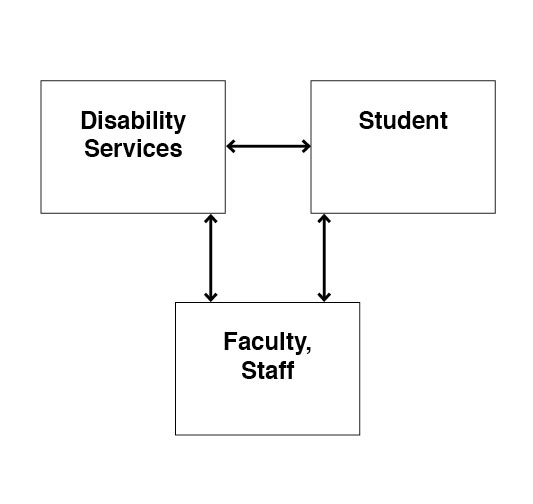
Visual #33
Campus Accessibility Indicators
1. Institution-level mission, vision, and values statements are inclusive of all people, including those with disabilities.
https://www.washington.edu/doit/accesscollege-systemic-change-postsecondary-institutions
Visual #34
Campus Accessibility Indicators
2. Disability is included in campus discussions of and training on diversity and special populations.
https://www.washington.edu/doit/accesscollege-systemic-change-postsecondary-institutions
Visual #35
Campus Accessibility Indicators
3. Policies, procedures, and practices are regularly reviewed for barrier removal and inclusivity of people with a diverse range of characteristics, including disability.
https://www.washington.edu/doit/accesscollege-systemic-change-postsecondary-institutions
Visual #35
Campus Accessibility Indicators
3. Policies, procedures, and practices are regularly reviewed for barrier removal and inclusivity of people with a diverse range of characteristics, including disability.
https://www.washington.edu/doit/accesscollege-systemic-change-postsecondary-institutions
Visual #36
Campus Accessibility Indicators
4. Administrators, staff, faculty, and student leaders are trained and empowered to take action around disability and universal design issues.
https://www.washington.edu/doit/accesscollege-systemic-change-postsecondary-institutions
Visual #37
Campus Accessibility Indicators
5. People with disabilities are visible (even if their disabilities are not) on campus including in positions of power and authority (e.g., administrators, faculty, student leaders).
https://www.washington.edu/doit/accesscollege-systemic-change-postsecondary-institutions
Visual #38
Campus Accessibility Indicators
6. Budgeting reflects the reality of the cost of applying universal design and of accommodating current and prospective employees, students, and visitors with disabilities.
https://www.washington.edu/doit/accesscollege-systemic-change-postsecondary-institutions
Visual #39
Campus Accessibility Indicators
7. Measures of student success (e.g., retention, course completion, graduation) are the same for all student populations, including students with disabilities, and institutional research includes this data.
https://www.washington.edu/doit/accesscollege-systemic-change-postsecondary-institutions
Visual #40
Campus Accessibility Indicators
8. Campus publications, websites, marketing, and public relations include images and content related to disabilities.
https://www.washington.edu/doit/accesscollege-systemic-change-postsecondary-institutions
Visual #41
Campus Accessibility Indicators
9. Campus publications and websites, including web-based courses, meet established accessibility standards.
https://www.washington.edu/doit/accesscollege-systemic-change-postsecondary-institutions
Visual #42
Campus Accessibility Indicators
10. Disability issues are regularly included as a component of the curriculum.
https://www.washington.edu/doit/accesscollege-systemic-change-postsecondary-institutions
Visual #43
Campus Accessibility Indicators
11. All campus facilities and other spaces are physically accessible.
https://www.washington.edu/doit/accesscollege-systemic-change-postsecondary-institutions
Visual #44
Visual #45
The Student Services Conference Room
https://www.washington.edu/doit/distance-learning-course-serving-students-disabilities
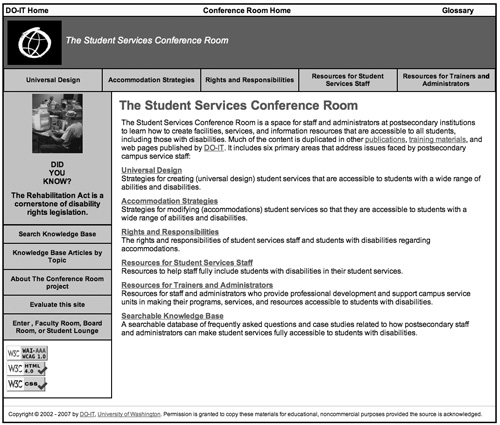
Visual #46
Visual #47
The Center for UD in Education
https://www.washington.edu/doit/programs/center-universal-design-education/overview
Videos and Publications
Videos and publications that can be used in a CBI are included in this binder. A larger collection is available at https://www.washington.edu/doit/resources/informational-briefs.
Videos
The following videos, which are included on DVDs in this binder, were created by DO-IT to promote the academic and career success of people with disabilities and the use of technology as an empowering tool. Most are freely available to view online at https://www.washington.edu/doit/videos/index.php. Downloadable versions to play from your computer may be obtained without charge by sending a request to doit@uw.edu.
Useful handouts that summarize the content and point to related resources for each presentation can be found on the DO-IT website. All videos are open-captioned for those with hearing impairments and audio-described versions are provided for those who are blind. Permission is granted to reproduce DO-IT videos and publications for educational, noncommercial purposes as long as the source is acknowledged.
Instruction and Student Services
- DO-IT College 1
- Working Together: Faculty and Students with Disabilities. Successful students with disabilities tell about techniques and accommodations that contributed to their success, emphasizing the importance of the faculty-student relationship. (9 minutes, © 1994)
- Building the Team: Faculty, Staff, and Students Working Together. Learn how to create an inclusive postsecondary learning environment. (16 minutes, © 2001)
- Equal Access: Universal Design of Instruction. Learn to make instruction in a classroom or tutoring center accessible to all students. (13 minutes, © 2006)
- Equal Access: Student Services. Learn how to apply universal design principles to make postsecondary student services accessible to all students. (15 minutes, © 2004)
- DO-IT College 2
- Invisible Disabilities and Postsecondary Education. Learn strategies to help students with learning disabilities, attention deficits, and other invisible disabilities achieve success in college. (19 minutes, © 2007)
- Self-Examination: How Accessible Is Your Campus? Learn issues to address to make a postsecondary institution welcoming and accessible to students with disabilities. (19 minutes, © 2007)
- Equal Access: Campus Libraries. How to apply universal design principles to make libraries accessible to all visitors. (10 minutes, © 2004)
- DO-IT STEM 1
- Working Together: Science Teachers and Students with Disabilities. Successful science students with disabilities suggest ways to make science activities accessible. (13 minutes, © 1998)
- Equal Access: Science and Students with Sensory Impairments. Students and employees with sensory impairments share strategies for success. (14 minutes, © 2005)
- The Winning Equation: Access + Attitude = Success in Math and Science. Science and math teachers share strategies for making these subjects accessible to students with disabilities. (15 minutes, © 1998)
- STEM: Science, Technology, Engineering, Mathematics at the University of Washington. Students and faculty highlight STEM programs offered to a diverse student body at the UW. (10 minutes, © 2000)
- DO-IT Transition 1
- College: You Can DO-IT! College students with disabilities and staff share advice for success in college. (14 minutes, © 1996)
- Moving On: The Two-Four Step. How to successfully transition from two- to four-year postsecondary institutions. (11 minutes, © 1998)
- Taking Charge 1: Three Stories of Success and Self-Determination. Successful young people with disabilities share strategies for living self-determined adult lives. (17 minutes, © 2001)
Careers
- DO-IT Careers 1
- Learn and Earn: Tips for Teens. Students with disabilities show how they benefit from work-based learning. (13 minutes, © 2001)
- Learn and Earn: Supporting Teens. Learn how parents, teachers, and mentors can encourage teens to participate in work-based learning. (13 minutes, © 2001)
- It's Your Career. College students with disabilities tell about the value of work-based learning. (13 minutes, © 1997)
- Access to the Future: Preparing Students with Disabilities for Careers. Learn how to make career services accessible to students with disabilities. (14 minutes, © 2000)
- DO-IT Self-Determination 1
- Taking Charge 1: Three Stories of Success and Self-Determination. Successful young people with disabilities share strategies for living self-determined lives. (17 minutes, © 2001)
- Taking Charge 2: Two Stories of Success and Self-Determination. Teens with disabilities share how they are learning to live self-determined lives. (15 minutes, © 2006)
- Taking Charge 3: Five Stories of Success and Self-Determination. This video combines the five stories presented in Taking Charge 1 & 2 videos. (27 minutes, © 2006)
Information Technology
- DO-IT Technology 1
- Working Together: People with Disabilities and Computer Technology. Individuals with disabilities demonstrate adaptive technology for people with mobility impairments, blindness, low vision, hearing and/or speech impairments, and learning disabilities. (14 minutes, © 2000, 1995)
- Working Together: Computers and People with Mobility Impairments. People with mobility impairments demonstrate computer access technology. (14 minutes, © 2001)
- Working Together: Computers and People with Sensory Impairments. People with visual and hearing impairments demonstrate computer technology for school and work. (11 minutes, © 2001)
- Working Together: Computers and People with Learning Disabilities. Students and workers with learning disabilities demonstrate computer-based tools and strategies. (12 minutes, © 2000)
- Computer Access: In Our Own Words. Students with disabilities demonstrate adaptive technology and computer applications. (10 minutes, © 2002)
- DO-IT Technology 2
- Equal Access: Computer Labs. Learn how computer labs can be designed as to be accessible to students with disabilities. (11 minutes, © 2006)
- World Wide Access: Accessible Web Design. People with disabilities describe roadblocks they encounter and examples of accessible web design. (11 minutes, © 2002, 1996)
- Real Connections: Making Distance Learning Accessible to Everyone. Learn issues to consider when designing courses to fully include students with disabilities. (12 minutes, © 2002)
- Access to Technology in the Workplace: In Our Own Words. Employees show how to make technology accessible. (13 minutes, © 2004)
- Camp: Beyond Summer. Learn how to add Internet experiences to summer camp programs for children and youth with disabilities. (10 minutes, © 1998)
DO-IT Programs and Overview
- DO-IT Programs 1
- DO-IT Pals: An Internet Community. Peers and mentors with disabilities support each other in an online community. (9 minutes, © 2005)
- DO-IT Scholars. High school students with disabilities prepare for college and careers. (11 minutes, © 1994)
- Snapshots: The DO-IT Scholars. DO-IT participants tell about their experiences. (28 minutes, © 1998)
- Finding Gold: Hiring the Best and the Brightest. Employers in work-based learning programs show how to fully include participants with disabilities. (7 minutes, © 1998)
- DO-IT Programs 2
- How DO-IT Does It. Successful practices employed by DO-IT programs to increase the success of young people with disabilities in college and careers. (34 minutes, © 2004)
- Opening Doors: Mentoring on the Internet. Mentors help students with disabilities achieve success in college studies and careers. (14 minutes, © 1998)
Publications
DO-IT maintains a large collection of publications that promote the academic and career success of people with disabilities and the use of technology as an empowering tool. All titles are available at https://www.washington.edu/doit/resources/informational-briefs. Listed below are those most relevant to the content of this notebook.
Instruction
- Academic Accommodations for Students with Learning Disabilities
- Academic Accommodations for Students with Psychiatric Disabilities
- An Accommodation Model
- Equal Access: Science and Students with Sensory Impairments
- Equal Access: Universal Design of Distance Learning
- Equal Access: Universal Design of Instruction
- Invisible Disabilities and Postsecondary Education
- Making Science Labs Accessible to Students with Disabilities
- Universal Design of Instruction: Definition, Principles, and Examples
- The Winning Equation: Access+Attitude =Success in Math and Science
- Working Together: Faculty and Students with Disabilities
- Working Together: Science Teachers and Students with Disabilities
- Working Together: Teaching Assistants and Students with Disabilities
Student Services
- Equal Access: Universal Design of Advising
- Equal Access: Universal Design of Career Services
- Equal Access: Universal Design of Financial Aid
- Equal Access: Universal Design of Housing and Residential Life
- Equal Access: Universal Design of Libraries
- Equal Access: Universal Design of Recruitment and Undergraduate Admissions
- Equal Access: Universal Design of Registration
- Equal Access: Universal Design of Student Organizations
- Equal Access: Universal Design of Student Services
- Equal Access: Universal Design of Tutoring and Learning Centers
- Equal Access: Universal Design of Your Project
- Real Connections: Making Distance Learning Accessible to Everyone
Careers
- Access to the Future: Preparing College Students with Disabilities for Careers
- Finding Gold: Hiring the Best and the Brightest
- It's Your Career: Work-Based Learning Opportunities for College Students with Disabilities
Information Technology
- Equal Access: Universal Design of Computer Labs
- Universal Design of Web Pages in Class Projects
- Web Accessibility: Guidelines for Administrators
- Working Together: Computers and People with Learning Disabilities
- Working Together: Computers and People with Mobility Impairments
- Working Together: Computers and People with Sensory Impairments
- Working Together: People with Disabilities and Computer Technology
- World Wide Access: Accessible Web Design
Overview and Resources
- AccessCollege: Systemic Change for Postsecondary Institutions
- College: You Can Do It!
- Disability-Related Resources on the Internet
- DO-IT Free Printed Publications
- DO-IT Videos and Training Materials
- Equal Access: Universal Design of Conference Exhibits and Presentations
- Equal Access: Universal Design of Professional Organizations
- Glossary of Disability-Related Terms
- Moving On: The Two-Four Step
- Self-Examination: How Inclusive Is Your Campus?
- Taking Charge: Stories of Success and Self-Determination
- Universal Design in Education: Principles and Applications
- Universal Design: Principles, Process, and Applications
